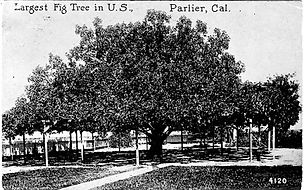FRESNO COUNTY
A Snapshot of the County in the Year 1900



Clovis Cole




Miller

Lux
In 1900, the city of Fresno, which had incorporated fifteen years earlier, was the county metropolis, a true Victorian city with its horse-car lines, dirt streets, and wood sidewalks. C. J. Craycroft was finishing the unexpired term of Joseph Spinney as mayor. Spinney, elected in 1895, served for only ten minutes, just long enough to make a brief speech resigning the post and nominating his political ally, Craycroft a drama that proved Fresno still had something to learn about civic government.
Fresno County's second city was Selma, with a population of more than 2,000. Selma had a raisin packing house, a flour mill, and several churches and fraternal organizations. The Selma Irrigator newspaper and its publisher, Mayor John Jay Vanderburgh, opposed Prohibition, but Selma became the Valley's first "dry" city in 1904.
Unincorporated communities in the county included Clovis, Centerville, Millerton, Pollasky, Reedley and Sanger. The birthplace of Fresno County, Millerton, was not much more than a memory by 1900. The old courthouse and businesses had been abandoned in 1872 when residents voted in favor of moving the county seat to Fresno Station. By 1900 all the land that had comprised the town and nearby Fort Miller was in the hands of the first county judge, Charles Hart, who remained a lifelong Millerton resident.
A small community just a few miles south of Millerton would grow in importance as the terminus of the Pollasky Railroad. Pollasky, later Friant, was a bustling center of activity with 150 residents.
South of Pollasky was the town of Academy, site of the county's first secondary school and home of James D. Collins, county sheriff. Down the road was the town of Clovis, located near Clovis Cole's Red Bank Ranch and with a population of 466. Clovis Cole, who came to Fresno County in 1873, owned more than 50,000 acres near the town.
Cole may have been the founder of Clovis, but it was Marcus Pollasky who put it on the map. Pollasky came to the county in 1891 and swindled many residents out of hard-earned dollars with a plan to build a rail line from Fresno over the Sierra Nevada mountains. The line was built only as far as Hamptonville, which was renamed Pollasky and later Friant. The Southern Pacific took control of Pollasky' s venture and kept the line in operation well into the twentieth century.
The town of Reedley was founded in 1888 by Thomas Law Reed, who farmed more than 16,000 acres of land. The big news of 1900 in Reedley was the building of a new post office. Both the Southern Pacific and Santa Fe railroads ran through Reedley, a shipping point for grain grown in the area.
I. N. Parlier was born in 1842 in Illinois. By 1873 his home was in Fresno County on a 640-acre farm near what would become the city bearing his name. Parlier worked for the Centerville and Kingsburg Canal and Irrigation Company as foreman and eventually president, in addition to being a vineyardist, merchant, banker, and postmaster. Parlier was responsible for much of the town's development and provided the right of way for the Santa Fe Railroad as well as the land for the depot. On a hot summer San Joaquin Valley day in 1900 you might find Mr. Parlier and his family hosting an event under what was purported to be the largest fig tree in the world, located near his home.
According to published reports, little had changed on Fresno County's western frontier during the 1890s. Population centers included Caruthers, Firebaugh, Mendota, Riverdale, and Huron. By 1900, the large tract known as Laguna de Tache had been divided, and Fresno City on the Slough, with its status as head of navigation and as a stop for stagecoaches, was nothing but a memory. The lack of dependable water supplies in the southwestern territory of the county had been a continual problem. Water needed to be shipped in for use by residents. Most of the development of the area would happen after the tum of the century.
The main "crops" of the region were oil wells, cattle, and sheep. Oil seeping from the ground had sparked an interest in many early pioneers throughout the county. Early efforts to collect the black gold were limited to skimming what was available on the surface. The first large-scale development of Fresno County oil fields was in the area surrounding Coalinga. In 1890, the Coast Range Oil Company of Los Angeles produced twenty barrels from one 135-foot well. By 1896, the number of barrels produced in a day was exceeding 300. In 1900 Coalinga was a small town with a few hundred residents along its main street, known as Whiskey Row, but was on its way to becoming an incorporated city, with a population of 4,199 in 1910.
Another location of note is the Shell Oil Company town known as Oilfields, which in 1899 was said to have the highest per capita wealth for its forty inhabitants of "any town in this or any state."
Henry Miller and his partner, Charles Lux, are believed to have owned more than 22,000 square miles of land in the Western United States. In 1900 the center of their Fresno County operation was the town of Firebaugh. Their control of water rights triggered numerous lawsuits and held hostage the distribution of Kings and San Joaquin rivers water for many years.
Mendota became a major stop for the railroad when the roundhouse and repair facility of the Southern Pacific Railroad was completed. Sheep shearing provided employment for hundreds of workers and the economies of both towns depended greatly on the nearby ranches, which were sold shortly after the tum of the century.
Source: Fresno County Historical Society, Past and Present Journal Vol 42 No. 4
Made Possible By These Generous Sponsors






.jpg)

